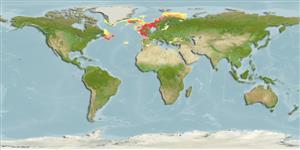Classification / Names
Common names from other countries
Main reference
आकार / वज़न / Age
Max length : 200 cm TL पुल्लिंग / अलिंग; (Ref. 1371); common length : 106 cm TL पुल्लिंग / अलिंग; (Ref. 1371); अधिकतम प्रकाशित वज़न: 45.0 kg (Ref. 35388); अधिकतम सूचित उम्र: 25 वर्षो (Ref. 35388)
Length at first maturity
Lm 90.0, range 90 - 100 cm
पर्यावरण
; समुद्री ड़िमरसल; औशिनोड़िरोमस (Ref. 51243); गहराई सीमा 100 - 1000 m (Ref. 35388), usually 100 - 400 m (Ref. 35388)
जलवायु / सीमा
Temperate, preferred 14°C (Ref. 107945); 75°N - 35°N, 55°W - 44°E (Ref. 54595)
वितरण
Northwest Atlantic: off southern Greenland and Canada. Northeast Atlantic: Barents Sea and Iceland to Morocco. Mediterranean Sea: northwestern Mediterranean only.
देश | ऐफ ऐ ओ क्षेत्र | Ecosystems | संयोग | भूमिका
Short description
पृष्ठीय रीढ़ (सम्पूर्ण): 0; पृष्ठीय सौफट रेज़ (सम्पूर्ण): 75-83; ऐनल सौफट रेज़: 58 - 64; जानवरों की रीड़ का जोड़: 63 - 65. Upper jaw projecting beyond lower one. Color is reddish brown dorsally, grading to white ventrally. The posterior areas of the vertical fins dark with pale margins. The sides distinctly marbled (Ref. 232). Barbel is present in the chin, longer than the diameter of the eye. Black spot in the rear end of the first dorsal fin. Caudal peduncle stout compared to blue ling (Ref. 35388).
IUCN Red List Status (Ref. 115185)
Threat to humans
Harmless
Human uses
मात्स्यिकी: उच्च वाणिज्य; आखेट मत्स्य: हां
अधिक जानकारी
संदर्भजलीयकृषिजलीयकृषि रूपरेखाखींचआनुवंशिकीऐल्लि आवृतियाँहैरेटिबिलटीबीमारीप्रक्रमणMass conversion
साधन
Special reports
Download XML
इंटरनेट स्रोत
Estimates of some properties based on models
Phylogenetic diversity index
PD50 = 0.6250 many relatives (e.g. carps) 0.5 - 2.0 few relatives (e.g. lungfishes)
Trophic Level
4.4 ±0.2 se; Based on diet studies.
लौटाव
निम्न, न्यूनतम जनसंख्या दुगनी होने का समय 4.5 - 14 वर्ष। (K=0.12; tm=5-6; tmax=25; Fec=60 million)
Vulnerability
Very high vulnerability (77 of 100)
Price category
